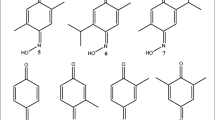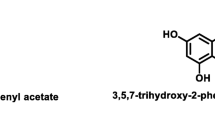Abstract
The cytotoxicity of crude insect drugs was measured using HeLa cells originating from human cervix and uterine cancer, using the dye uptake assay in order to find potential anticancer agents. Three kinds of extracts (buffer, methanol and ethylacetate) were prepared from 26 insects and used as raw materials for the activity assay. Among these, the buffer extracts from Tabanus, Mylabris and Huechys showed a potent anticancer activity, and those from Catharsius, Red ant, Scorpion, Tabanus and Vespae Nidus showed a strong L-amino acid oxidase (AAO) activity as well as cytotoxicity. In contrast, buffer extracts fromCryllotalpa orientalis andApriona germari larvae showed greater/more rapid Hela cell growth than that of other insects.
Similar content being viewed by others
References
Ahn, M. Y., Lee, B. M. and Kim, Y. S., Characterization and cytotoxicity of L-amino acid oxidase from the venom of king cobra (Ophiophagus hannah).Int. J. Biochem. Cell. Biol. 29, 911–919 (1997A).
Ahn, M. Y., Lee, B. M. and Kim, Y. S., Cytotoxicity and L-amino acid oxidase activity of animal venoms.Arch. Pharm. Res., 20, 13–16 (1997B).
Bradford, M. M., A rapid and sensitive method for the quantitation of microgram quantities of protein utilizing the principle of protein-dye binding.Anal. Biochem., 72, 248–254 (1976).
Bomalaski, J. S., Ford, T., Hudson, A. P. and Clark, M. A., Phospholipase A2-activating protein induces the synthesis of IL-1 and TNF in human monocytes.J. immunol. 154, 4027–4031 (1995).
Beresford, P. J., Basinski-Gray, J. M., Chiu, J. K., Chadwick J. S. and Aston, W. P., Characterization of hemolytic and cytotoxic Gallysins: a relationship with arylphorins.Dev. Comp. Immunol., 21, 253–266 (1997).
Cohen, E. and Quistad, G. B., Cytotoxic effects of arthropod venoms on various cultured cells.Toxicon, 36, 353–358 (1998).
Degrado, W. F., Musso, G. F., Lieber, M., Kaiser, E. T. and Kezdy F. J., Kinetics and mechanism of hemolysis induced by mellitin and by a synthetic mellitin analogue.Biophys. J., 37, 329–338 (1982).
Geldof, A. A., Mastbergen, S. C., Henrar, R. E. and Faircloth, G. T., Cytotoxicity and neurocytotoxicity of new marine anticancer agents evaluated usingin vitro assays.Cancer Chemother. Pharmacol., 44, 312–318 (1999).
Hara, seiichi and Yamakawa minoru, Moricin, a novel type of antibacterial peptide isolated from the silkworm,Bombyx mori, J. Biol. Chem., 270, 29923–29927 (1995).
Holme, D. J. and Goldberg, D. M., Coupled optical rate determination of amino acid oxidase activity.Biochim. Biophys. Acta, 377, 61–70 (1975).
Itoh, A., Ohsawa, F., Ohkuma, Y. and Natori, S., Participation of tumor killing factor in the antitumor effect of Sarcophaga lectin.FEBS. Lett., 201, 37–40 (1986A).
Itoh, A., Ohsawa, F. and Natori, S., Purification of a cytotoxic protein produced by the murine macrophage-like cell line J774.1 in response to Sarcophaga lectin.J. Biochem., 99, 9–15 (1986B).
Kono, T., Watanabe, M., Koyama, K., Kishimoto T., Fukushima, S. and Sugimura, T., Wakabayashi, K., Cytotoxic activity of pierisin, from the cabbage butterfly, Pieris rapae, in various human cancer cell lines.Cancer Lett., 137, 75–81 (1999).
Mack, P., Ha, X. F. and Cheng, L. Y., Efficacy of intra-arterial norcantharidin in suppressing tumor14C-labelled glucose oxidative metabolism in rat.HPB Surg., 10, 65–72 (1996).
Markland, F. S., Effect of snake venom proteins on tumor growth. In Stocker, K. F. (Eds.),Medical use of snake venom proteins, CRC Press, Boca Raton, Florida, 1990, pp. 175–199.
Martikainen, P., Nyman, K. and Nevalainen, T., Toxic effects of human pancreatic and snake and bee venom phospholipase A2 on MCF-7 cells in culture.Toxicon, 31, 835–843 (1993).
Minoura, N., Aiba, S. I., Higuchi, M., Gotoh, Y., Tsukada, M. and Imai, Y., Attachment and growth of fibroblast cells on silk fibroin.Biochim. Biophys. Res. Comm., 208, 511–516 (1995).
Moore, A. J., Beazley, W. D., Bibby, M. C. and Devine, D. A., Antimicrobial activity of cecropins.J. Antimicrob. chemother., 37, 1077–1089 (1996).
Nakajima, Y. and Natori, S., Anti-tumor factor in insect’ hemolymph.Hum. Cell, 3, 131–136 (1990).
Newman, R. A., Vidal, J. C., Viskatis, L. J., Johnson, J. and Etcheverry, M. A., VRCTC-310 — A novel compound of purified animal toxins separates antitumor efficacy from neurotoxicity.Invest. New Drugs, 11, 151–159 (1993).
Stocker, K., Application of snake venom proteins in the diagnosis of hemostatic disorders. In Stocker, K. F. (Eds.),Medical use of snake venom proteins CRC Press, Boca Raton, Florida, 1990, pp. 225.
Terada, S., Kimoto, E. and Tsuzuki, Y., Chemical component in snake venom acting on tumor cells.Fukuoka. Univ. Sci. Reports, 18, 65–74 (1988).
Wu, Q. X., King, M. A., Donovan, G. R., Alewood, P., Sawyer, W. H. and Baldo, B. A., Cytotoxicity of pilosulin 1, a peptide from the venom of the jumper ant.Myrmecia pilosula.Biochim. Biophys. Acta, 1425, 74–80 (1998).
Yi, S. N., Wass, J., Vincent, P. and Iland, H., Inhibitory effect of norcantharidin on K562 human myeloid leukemia cells in vitro.Leuk. Res., 15, 883–886 (1991).
Author information
Authors and Affiliations
Corresponding author
Rights and permissions
About this article
Cite this article
Ahn, M.Y., Ryu, K.S., Lee, Y.W. et al. Cytotoxicity and L-amino acid oxidase activity of crude insect drugs. Arch Pharm Res 23, 477–481 (2000). https://doi.org/10.1007/BF02976576
Received:
Issue Date:
DOI: https://doi.org/10.1007/BF02976576




